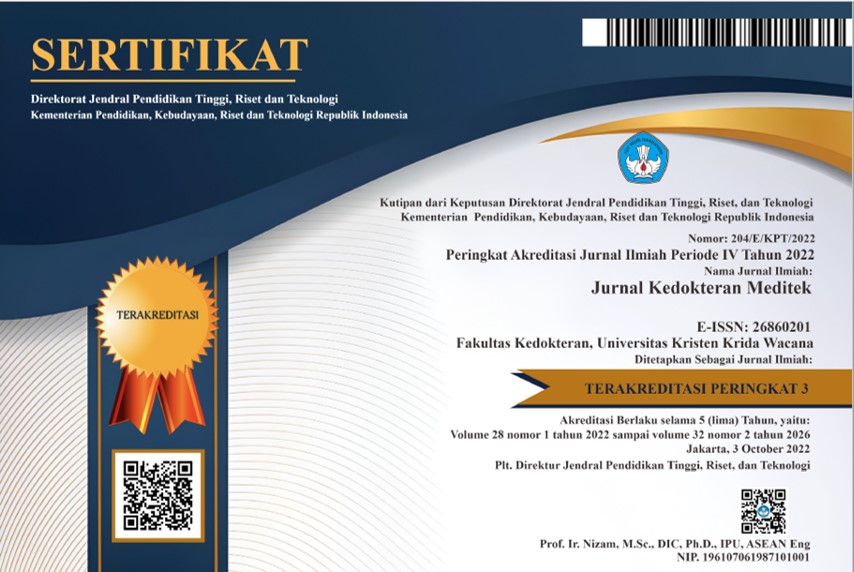Expression of Nuclear Factor – kappa B (NF-kB) in Human Breast Cancer Stem Cells (CD 24-/CD 44+) Treated with H2O2 and Its Relationship with Cell Viability
DOI:
https://doi.org/10.36452/jkdoktmeditek.v29i2.2668Keywords:
antioxidant, cancer stem cells, H2O2, NF-kB, oxidative stressAbstract
Introduction: Breast cancer is one of the highest causes of death from cancer in women in Indonesia. This is partly due to the resistance of ROS-based therapies such as radiotherapy and chemotherapy. Breast cancer stem cells (cancer stem cells, CSCs) have a role in this resistance mechanism. Previous studies demonstrated the ability of CSC to survive oxidative stress conditions due to rotenone administration. Therefore, in this study an analysis was carried out on the transcription factor NF-kB in breast cancer cells, both CSCs and Non CSCs, related to the role of NF-kB in maintaining the survival of cancer cells under conditions of oxidative stress. Methods: The study was conducted on human breast cancer stem cells (CD24-/CD44+) and non stem cells (CD24-/CD44-) which were given H2O2 at concentrations of 1.1µM, 11µM, and 110µM with control cells not given H2O2. Assessment was carried out on the parameters of NF-kB mRNA expression, and cell viability. Results: Administration of H2O2 at a concentration of 11µM showed a significant increase in the expression of NFk-B CSCs mRNA compared to non CSCs (p<0.05). As for the viability test results, at all concentrations of H2O2 it appears that CSCs was able to maintain its viability compared to non CSCs which experienced a decrease in viability (p<0.05). Conclusion: In this study, conditions of oxidative stress due to the administration of H2O2 led to an increase in the expression of NF-kB mRNA in CSCs so that cell viability could be maintained.
References
Breast Cancer Overview 2014. [Internet]. [cited 2014 May 22]. Available from: http://www.cancer.org/acs/groups/cid/documents/webcontent/003037-pdf.pdf.
Cancer incidence, mortality worldwide (GLOBOCAN) in 2012. [Internet]. [ cited 2014 May 22 ]. Available from: http://globocan.iarc.fr/Pages/ pie_pop_sel.aspx.
Betty S, Meredith W, Kimberly ST. Breast cancer treatments and complications: Implications for rehabilitation. Rehabilitation Oncology. 2009;27(3):16-26.
Halliwel B, Gutteridge JMC. Free radical in biology and medicine. 4th ed. Oxford University Press.2007; 79-105.
Hu Y, Rosen DG, Zhou Y, Feng L, Yang G, et al. mitochondrial manganese-superoxide dismutase expression in ovarium cancer: role in cell proliferation and response to oxidative stress. J Biol Chem. 2005; 280:39485-92.
Dayem AA, Choi HY, Kim JH, Cho SG. Role of oxidative stress in stem, cancer and cancer stem cells. Cancers. 2010; 2:859-84.
Diehn M, Cho RW, Lobo NA, Kalisky T, Dorie MJ, et al. Association of reactive oxygen species levels and radioresistance in cancer stem cells. Nature 2009; 458:780-3.
Ransy C, Vaz C, Lombes A, Bouillaud F. Use of H2O2 to cause oxidative stress, the catalase issue. Int J Mol Sci. 2020;21(23):9149.
Shipitsin M, Polyak K. The cancer stem cell hypothesis: in search of definitions, markers and relevance. Lab Invest. 2008;88:459-63.
Zuoren Y, Timothy GP, Michael PL, Richard GP. Cancer stem cells. Int J Biochem Cell Biol. 2012; 44(12): 2144-2151.
Ghmkin H, Said MA, Shiro K, Akimasa S, Hiroko I, Yucheng S et al. Cancer stem cell Microenvironment models with biomaterial scaffolds in vitro. Processes. 2021; 9: 45.
Sugong C, Emina HH. The colon cancer stem cell microenvirontment hold keys to future cancer thrrapy. J Gastrointest Surg. 2014;18:1040-8.
Plaks V, Kong N, Werb Z. The cancer stem cell niche: how essential is the niche in regulating stemness of tumor cells. Cell Stem Cell. 2015;16(3):225-38.
Gloire G, Legrand-Poels S, Piette J. NF-kB activation by reactive oxygen species: fifteen years later. Biochemical pharmacology. 2006;72:1493–505.
Niederberger E, Geisslinger G. Analysis of NF-kB signaling pathway by proteomic approaches. Expert Rev. Proteomics. 2010;7(2):189-203.
Perkins ND, Gilmore TD. Good cop, bad cop: the different faces of NF-kB. Cell Death and Differentiation. 2006;13:759-72.
Elizabeth V, Alisan D. Hydrogen peroxide as a signaling molecule. Antioxidant & redox signaling 2011;15:147-51.
Guangxian Z, Shenghui Qin, Danyelle T, Bradley AS, Kenneth DT, Gavin YW. Oxidative stress induces senescence in breast cancer stem cells. Biochem biophys res commun. 2019;4:1204-9
Phi LTH, Sari IN, Yang YG, Lee SH, Jun NKim KS et al. Cancer stem cells (CSCs) in drug resistance and their therapeutic implications in cancer treatment. Stem cells int. 2018;5416923.
Shi LYP, Zhao G, Xu J, Peng W, Zhang J, Zhang G et al. Targeting cancer stem cell pathways for cancer therapy. Signal transduction and targeted therapy. 2020;5:8.
Downloads
Published
How to Cite
Issue
Section
License
Copyright (c) 2023 Hendrik Kurniawan, Septelia Inawati Wanandi, Sri Widia A. Jusman

This work is licensed under a Creative Commons Attribution-NonCommercial-ShareAlike 4.0 International License.

















